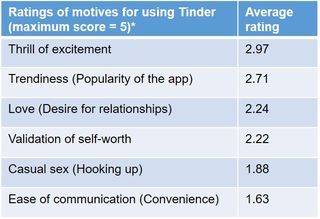Mating
Is Tinder Really a Hookup App?
Research explores why people use Tinder and what kinds of connections they make.
Posted June 11, 2017 Reviewed by Lybi Ma
Key points
- A survey showed the majority of people believe that Tinder is a hookup app.
- The main reason people report using Tinder is that it’s popular and trendy.
- Among those looking for romance, people are more likely to use Tinder to look for a relationship than a hookup.

Since its launch in 2012, the dating app, Tinder, has received quite a bit of publicity. It's one of the most popular lifestyle apps with over 10 million daily active users.
For the uninitiated, Tinder is a mobile dating app that allows users to locate other singles in their geographic area. Users fill out a brief bio and upload photos. They can then start viewing photos of other users who match their age, gender, and location criteria. Users swipe right if they like what they see and swipe left if they don’t. They are then notified of any matches, where both people swiped right on each other's profiles. Thus, users can quickly view hundreds of local singles and decide with a quick swipe of their finger if they’re interested or not.
In the popular media, Tinder very much has the reputation of being a "hookup" app, designed to facilitate fleeting sexual encounters. At the peak of the Tinder hype, an article in Vanity Fair announced that Tinder represented the "dawn of the dating apocalypse." Whereas others in the popular media have suggested that many use the app in search of love.
So, why do people use Tinder?
Two recent studies shed some light on all of the hype.
A recently published study by Leah LeFebvre surveyed 395 young adults (ages 18 to 34) who said they had used Tinder.1 The study mostly involved open-ended questions regarding users' motivations for and experiences using the app. The researchers then coded participants' responses into categories.
So what was the most commonly cited reason for using Tinder? It's popular: 48.3 percent of the respondents indicated that the main reason they used Tinder revolved around its popularity—the media hype or the fact that many of their peers were using it. Only about 5 percent of those surveyed indicated that the desire for hookups was their main motivation for joining the site. This data is summarized in the table below.

The participants were also asked what was the purpose of Tinder. When it came to people’s perceptions, not surprisingly, they were true to stereotype. 51.5 percent said they believed Tinder was designed for hooking up, 33.5 percent said dating, and 15 percent meeting people.
While this open-ended data is valuable, it doesn't provide the whole story on why people use Tinder. Participants in LeFebvre's study were asked what their main reason was for using the app, but people often have multiple motivations for their behaviors. Someone might primarily have joined Tinder because it seemed like the cool thing to do, but that person might also have a desire to meet a potential romantic partner or hookup.
In another recent study, by Sindy Sumter and colleagues, a sample of 163 Dutch Tinder users rated the extent to which various motives described their reasons for using Tinder.2 The researchers then used a statistical technique to group those ratings into general categories. The categories and the average ratings of the participants for each category are summarized in the table below.

The most common motives for using Tinder: it's exciting and it's trendy. Another common motive that wasn't cited in the LeFebvre study was self-worth validation. It was not uncommon for participants to use the app because they wanted positive feedback on Tinder or because receiving such feedback felt good. Naturally, finding a romantic partner was also a relatively common reason for using Tinder. As can be seen in the table, using the app for casual sex and hookups was actually less common than these other motives.
Not surprisingly, both studies also suggested that men are more likely than women to use Tinder for the purpose of seeking out casual sex.
These studies show that using Tinder meets a variety of psychological needs, beyond the obvious ones relating to dating and sex. Tinder can also be used to fulfill more general social needs. Both studies showed that the trendiness and excitement of the app were larger drivers of its use than motivations that relate to what most users believe to be its purpose (dating, sex). It can also help to fulfill our needs for self-worth. Receiving matches on Tinder can be an ego boost. On the other hand, not receiving matches could damage self-worth, and in fact, LeFebvre found that lack of success on Tinder, including not receiving matches, was one of the main reasons users quit the app.1
What do people do when they get a Tinder match?
In LeFebvre's qualitative study, 77 percent of the respondents indicated that they had met a match in person at some point, with the average participant reporting 4.58 offline meetings with matches. And in fact, 37 percent reported that a Tinder date led to an exclusive dating relationship. What about those infamous hookups? Well, these participants did do plenty of hooking up. Of those who met a Tinder match in person, only 21.8 percent indicated that they had never hooked up. Another 12.6 percent said they had hooked up but it didn’t involve sexual intercourse and another 65.6 percent said their hookups did involve sexual contact. In addition, the average number of hookups reported by the participants was just above three.
Participants in the Dutch study seemed to be less successful on Tinder. Slightly fewer than half of the participants (45.5 percent) had gone on an offline date with a match, and 18.6 percent reported having had a one-night stand. This rate is much lower, but other data from this study indicates that these participants were overall less active on the app than the participants in LeFebvre's study.
How do motives for using Tinder relate to people’s experiences?
You might also be wondering how Tinder users' motives for using the app relate to their actual use of the app. LeFebvre's qualitative data couldn't really address this question, but Sumter and colleagues were able to examine the association between Tinder use motives and participants' likelihood of going on a Tinder date or having a Tinder hookup.2
Those who were looking for love or casual sex were more likely to go on Tinder dates. Not surprisingly, the more that participants indicated casual sex as a motive for using Tinder, the more likely they were to have a one-night stand with a Tinder match. Those who used Tinder as a way to boost their feelings of self-worth were less likely to have a one night stand. Interestingly, those who used Tinder because it seemed like an easier way to meet people were actually less likely to go on dates with Tinder matches. Perhaps these individuals were especially likely to be shy and thus ultimately didn't follow through with their Tinder matches.
So what do we really know about Tinder?
Returning to the question that began this post, is Tinder really a hookup app? Yes and no. Tinder-initiated hookups are quite common, but the notion that Tinder is primarily about hookups is overstated. Tinder users are more likely to be seeking relationships than casual sex. Moreover, dating and sex are not the main reasons that many people are using Tinder.
These two studies give us a window into the motives of Tinder users, but ultimately it's hard to generalize the findings. As I pointed out, the actual dating and hookup experiences of the two samples of participants differed considerably. So which experience is closer to that of the typical Tinder user? It’s hard to definitively say without surveys that seek out a representative sample of Tinder users. Nonetheless, both studies suggest that much of Tinder's popularity is, ironically, due to its popularity. This may not be the best news for those who really do use Tinder to look for love or sex, as they may find that their matches don't take the app very seriously and aren't as interested in following through.
We also know very little about the long-term prospects of Tinder-initiated relationships. Traditional online dating websites, like match.com, have been around long enough that researchers are starting to understand the prognosis for those relationships and the types of people who use the sites. What does the future hold for Tinder and its users? Only time and more research will tell.
References
1. LeFebvre, L. E. (2017). Swiping me off my feet: Explicating relationship initiation on Tinder. Journal of Social and Personal Relationships. Published online before print. doi: 10.1177/0265407517706419
2. Sumter, S., Vandenbosch, L., & Ligtenberg, L. (2016). Love me Tinder: Untangling emerging adults’ motivations for using the dating application Tinder. Telematics and Informatics, 34(1), 67-78. doi:10.1016/j.tele.2016.04.009




